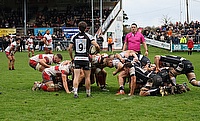The finances of Semi-Professional Rugby - TRU Investigates (Part 4)
With potential reform of Championship rugby as a professional league continuing to serve as one of the most pressing debates in English rugby, the possible implications of such reform to semi-professional leagues must also be considered.
Should the proposed reforms to England’s second division fail, is an exclusively semi-professional network of clubs and leagues underneath the Premiership a viable alternative?
It is hard to envision the current crop of (professional) Championship players readily accepting a reduction in wages and employment along with the prospect of finding part-time work to supplement their income, but as alluded to last week this is already becoming a practice that affects a small number of individuals at Championship level.
Indeed, the unfortunate current trend in lower-league rugby suggests clubs like London Welsh or Jersey - clubs forced to absorb substantial financial losses and subsequent points deductions - are becoming the norm over success stories like Richmond who maintained a fully semi professional team model, following their promotion to the Championship this season (2016-17) after a number of years languishing at the bottom of the RFU league pyramid.
For the sake of hypotheticals however, if the Championship was forced to merge into semi-professionalism what would a realistic league structure look like?
To begin with, the existing league structure for Level 2 (Championship), Level 3 (National League 1) Level 4 (National League 2 North and South) would require significant restructuring. With Championship teams mandated to be fully professional, the change in club status would require the current twelve teams to be integrated into either the semi-professional leagues currently below them or, more likely, as part of a new semi-professional league.
This new league would house a combination of the Championship sides unable to prove their ability to meet a minimum financial criteria to form part of a new ring-fenced Premiership and the sides currently playing in National League 1. The league could then form a roughly 26-team ‘super league’ or be split into two separate leagues depending on geographical location, akin to National League 2. Promotion/relegation between Leagues 1 and 2 could remain and if the reformed National League 1 is split by geographical region, an inter-league playoff series could decide an annual second-tier champion. Teams would then be able to apply to join the Premiership from the lower-leagues should they prove capable of the financial obligations membership would entail. Unfortunately, a ring-fenced Premiership is unavoidable with full, lower-league semi-professionalism.
The other repercussion of a sudden expansion of semi-pro clubs and players would necessitate an expansion of the tours conducted by the England Counties team. Currently averaging only four games a season, the RFU should increase the funding available to the Select XV in order to incentive international representation for semi-professional players. Expanding the England Counties schedule could also help the RFU forge greater links with developing rugby nations as they have in previous season with Romania and Canada amongst others.
The other potential possibility of a reformed solely semi-pro league structure under the Premiership would be to expand on the proposed Major League Baseball-style farm system proposed by RFU Director Nigel Melville last year. Instead of the current structure which limits the potential for Premiership clubs to loan young players on the first team periphery in desperate need of gametime, the RFU could mandate all Premiership clubs, as a requirement of the protection offered them in a ring-fenced Premiership, forge connections with the semi-professional clubs immediately below them and designate a certain amount of players for loan each season. This would allow the lower-league clubs to limit wage expenses and ensure the link between professional clubs and lower-tier clubs does not dissolve completely.
In addition, it would also improve the standard of the semi-professional leagues and allow the next generation of professional rugby to cut their teeth with extensive experience at a lower level. The other benefit of having young professional players involved with the clubs would be the additional flexibility it would afford the semi-professional players to pursue activities outside of rugby. This plan would also see the development of stronger regional rugby links, helping to aid the growth of the game in areas which have historically struggled to forge a consistent and comprehensive connection from grassroots club to the professional level.
Admittedly, the possibility of a semi-professional merger between the Championship and National Leagues is far from ideal and the suggestions listed here are very much only jumping off points should an expanded semi-professional tier be the only feasible option for lower-league rugby in the future.
But an end to two-tiers of professional rugby does not have to signal an end of competitiveness in the lower-levels, even if the current league structure ultimately proves unsustainable. The death of lower-league professionalism would be a great indictment on the RFU’s management of the entire English league structure, but with careful management it could still lead to the continued growth of the game of Union beyond the Premiership.








